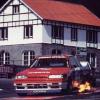Am i unlucky
Announcements
-
Latest Posts
-
By hoodedreeper · Posted
Here's a boring history lesson on number plates People want illegal spacing to make their plate more readable, if mine was J2X BK, anyone who knows about the car would see that its spelling JZX. Years ago third party plate manufacturers could alter the text to make it look like something else, nowadays the computer software is locks that ability (well, ours does at work) Up until 2001 the first letter of a number plate represented the year of the vehicle, for example A would be 1983. (pre 1983, the format was backwards, so the year letter was on the end). Followed by 3 random numbers and 3 random letters. Things started to get complicated at the end of the 90s where T and V were 1999, W and X were 2000 and Y was early 2001. From 2001 they introduced a new 'layout' where the first two characters are letters, this represented where that vehicle was first registered in the country. The letters corrosponded to a region in the country. Some regions had a large number of codes, where as some only had a couple (despite being large in physical land size) Next are 2 numbers to indicate 2000s. So it went from: Y (March 1999 > Aug 2000) 51 (Sept 2001 > Feb 2002) 02 (March 2002 > Aug 2002) 52 (Sept 2002 > Feb 2003) etc etc When the 2010s got here, the numbers changed again, going up by tens 10 (March 2010 > Aug 2010) 60 (Sept 2010 > Feb 2011) When the 2020s arrived it went to 20 (March 2020 > Aug 2020) 70 (Sept 2020 > Feb 2021) etc As for personalised plates, you're not allowed a registration that makes the vehicle look newer. Take my 110 for example, its a 2004 car so I can have any available plate upto 04. I can't have a 54 because it was manufactured in August 2004. Which allows me to have a J plate, because its older (if that makes sense) -
Mount some of these on your dash? https://www.greddy.com/products/16001720
-
By Dose Pipe Sutututu · Posted
Given you're running a 2.8 and my 2.5 is not really like for like, I suspect there could be a bit more timing you could give it. What is the kW yield per degree you're putting through it? Here's my E85 map to give you an idea, where it was I could still get another 3~4kW per degree thrown at it. -
It turns out that Setrab make a fan specifically for the oil cooler which is great and I've installed it with minimal swearing. I removed my 2x 12in push fans from the front of my aircon condenser and wired them into this. My main thermo fans kick on when I use the aircon anyway and would effectively already be working as puller fans through the condensor which is infront of the rad. The push fans (understandably) didn't really do much in the config they were previously in so now they're out. Now we're on to the "Oil fan doesn't really do much either!". Yes I'll duct it next if it does nothing in heavy use which it shouldn't. But hey, the object exists and fits great and is cool. Let me have this. The car is still in the "do my fittings leak oil now? do my wheels actually rub?" phase. I did a spirited drive on them and didn't hear or feel anything. Then I got back home and noticed there were grind marks on the inside of the rims, though I couldn't see where they were touching I got out the grinder and attacked the suspects. Note: I do not know how to use a grinder. Then I realised I had dragged my new rims across my concrete driveway before I did this drive. I didn't think I had damage at that time when I briefly looked...... but remembered this occurred after I did all the angle grinding. The grinding on the wheels in some very specific spots. It's not around the whole rim for example, which lines up with dragging it across concrete more than hitting a suspension component for even 1 full rotation. So everything is currently painted and taped up and I need to test it some more to see if it really IS rubbing, but from inside the car it doesn't feel like it is. In other news I attempted to do a before and after comparison of the heads/cam upgrade thing. Dynos lie, everything is in different measurements. Here is the data from the sandown back straight. Car go faster than before. Vroom vroom.
-
By TurboTapin · Posted
Here's my base ignition. +3 correction to redline when shooting water/meth which is always on. Looking at my old ignition table, I should be able to add 1-2 degree's next time I'm on the dyno. Let me know your thoughts.
-





Recommended Posts
Create an account or sign in to comment
You need to be a member in order to leave a comment
Create an account
Sign up for a new account in our community. It's easy!
Register a new accountSign in
Already have an account? Sign in here.
Sign In Now